CHEVROLET KODIAK 2008 Service Manual
Manufacturer: CHEVROLET, Model Year: 2008, Model line: KODIAK, Model: CHEVROLET KODIAK 2008Pages: 384, PDF Size: 5.4 MB
Page 41 of 384
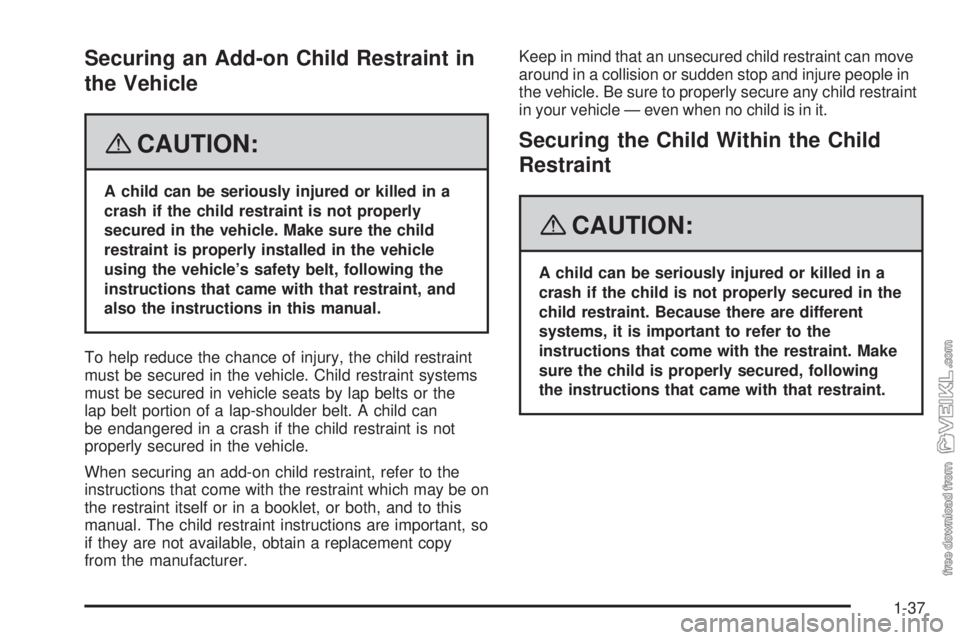
Securing an Add-on Child Restraint in
the Vehicle
{CAUTION:
A child can be seriously injured or killed in a
crash if the child restraint is not properly
secured in the vehicle. Make sure the child
restraint is properly installed in the vehicle
using the vehicle’s safety belt, following the
instructions that came with that restraint, and
also the instructions in this manual.
To help reduce the chance of injury, the child restraint
must be secured in the vehicle. Child restraint systems
must be secured in vehicle seats by lap belts or the
lap belt portion of a lap-shoulder belt. A child can
be endangered in a crash if the child restraint is not
properly secured in the vehicle.
When securing an add-on child restraint, refer to the
instructions that come with the restraint which may be on
the restraint itself or in a booklet, or both, and to this
manual. The child restraint instructions are important, so
if they are not available, obtain a replacement copy
from the manufacturer.Keep in mind that an unsecured child restraint can move
around in a collision or sudden stop and injure people in
the vehicle. Be sure to properly secure any child restraint
in your vehicle — even when no child is in it.
Securing the Child Within the Child
Restraint
{CAUTION:
A child can be seriously injured or killed in a
crash if the child is not properly secured in the
child restraint. Because there are different
systems, it is important to refer to the
instructions that come with the restraint. Make
sure the child is properly secured, following
the instructions that came with that restraint.
1-37
Page 42 of 384
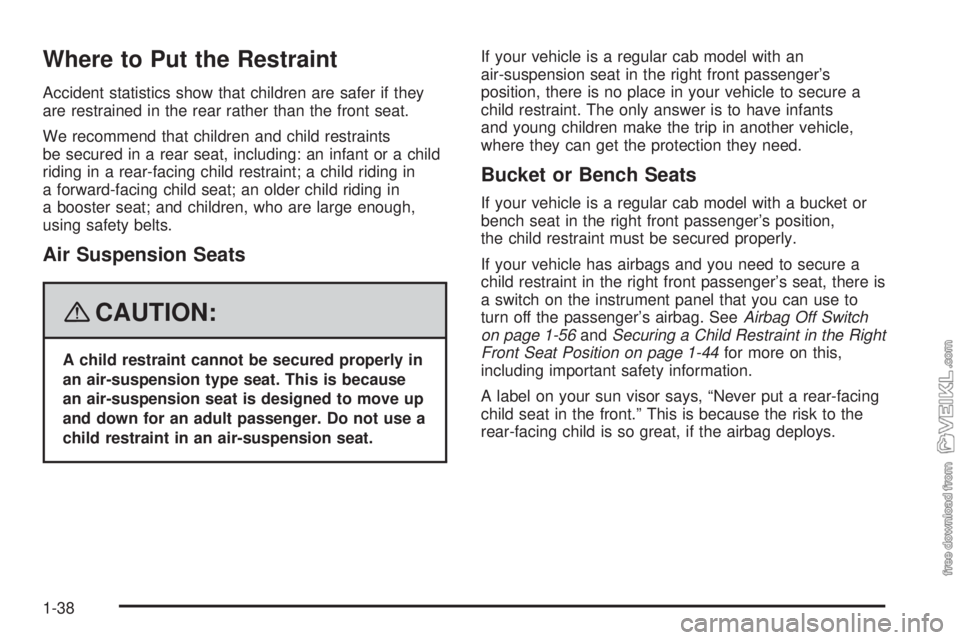
Where to Put the Restraint
Accident statistics show that children are safer if they
are restrained in the rear rather than the front seat.
We recommend that children and child restraints
be secured in a rear seat, including: an infant or a child
riding in a rear-facing child restraint; a child riding in
a forward-facing child seat; an older child riding in
a booster seat; and children, who are large enough,
using safety belts.
Air Suspension Seats
{CAUTION:
A child restraint cannot be secured properly in
an air-suspension type seat. This is because
an air-suspension seat is designed to move up
and down for an adult passenger. Do not use a
child restraint in an air-suspension seat.If your vehicle is a regular cab model with an
air-suspension seat in the right front passenger’s
position, there is no place in your vehicle to secure a
child restraint. The only answer is to have infants
and young children make the trip in another vehicle,
where they can get the protection they need.
Bucket or Bench Seats
If your vehicle is a regular cab model with a bucket or
bench seat in the right front passenger’s position,
the child restraint must be secured properly.
If your vehicle has airbags and you need to secure a
child restraint in the right front passenger’s seat, there is
a switch on the instrument panel that you can use to
turn off the passenger’s airbag. SeeAirbag Off Switch
on page 1-56andSecuring a Child Restraint in the Right
Front Seat Position on page 1-44for more on this,
including important safety information.
A label on your sun visor says, “Never put a rear-facing
child seat in the front.” This is because the risk to the
rear-facing child is so great, if the airbag deploys.
1-38
Page 43 of 384
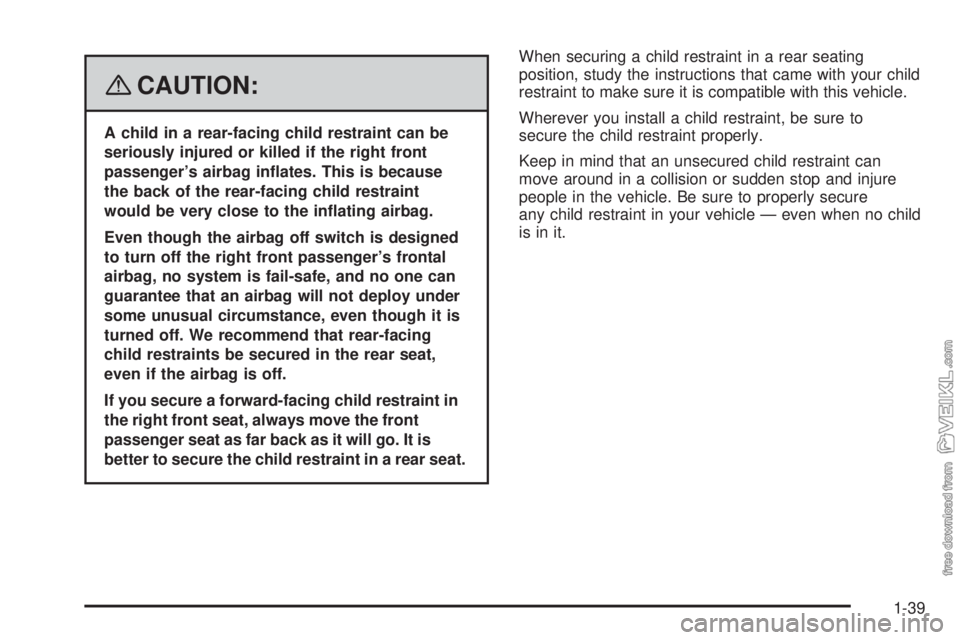
{CAUTION:
A child in a rear-facing child restraint can be
seriously injured or killed if the right front
passenger’s airbag in�ates. This is because
the back of the rear-facing child restraint
would be very close to the in�ating airbag.
Even though the airbag off switch is designed
to turn off the right front passenger’s frontal
airbag, no system is fail-safe, and no one can
guarantee that an airbag will not deploy under
some unusual circumstance, even though it is
turned off. We recommend that rear-facing
child restraints be secured in the rear seat,
even if the airbag is off.
If you secure a forward-facing child restraint in
the right front seat, always move the front
passenger seat as far back as it will go. It is
better to secure the child restraint in a rear seat.When securing a child restraint in a rear seating
position, study the instructions that came with your child
restraint to make sure it is compatible with this vehicle.
Wherever you install a child restraint, be sure to
secure the child restraint properly.
Keep in mind that an unsecured child restraint can
move around in a collision or sudden stop and injure
people in the vehicle. Be sure to properly secure
any child restraint in your vehicle — even when no child
is in it.
1-39
Page 44 of 384
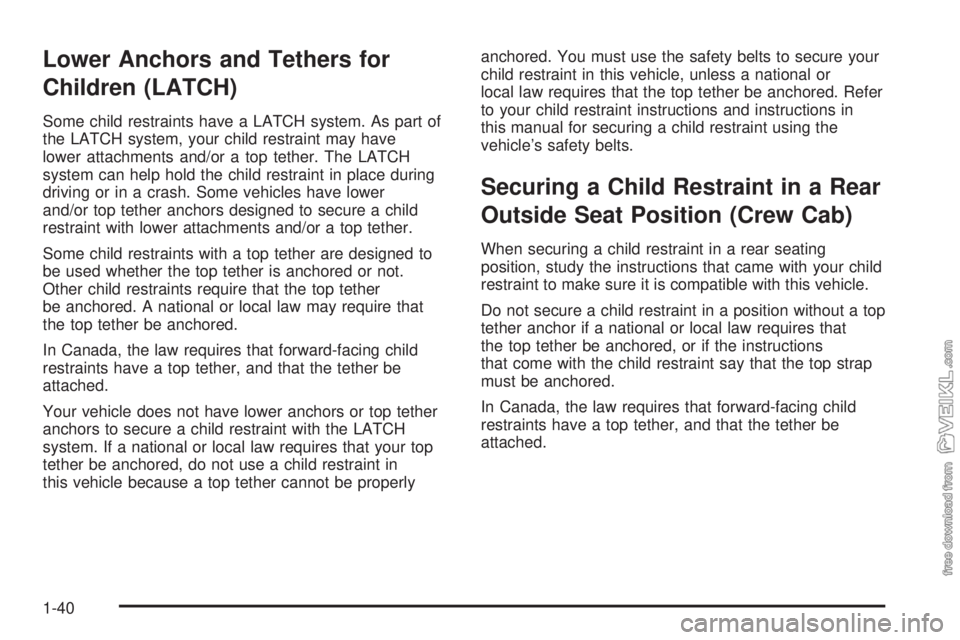
Lower Anchors and Tethers for
Children (LATCH)
Some child restraints have a LATCH system. As part of
the LATCH system, your child restraint may have
lower attachments and/or a top tether. The LATCH
system can help hold the child restraint in place during
driving or in a crash. Some vehicles have lower
and/or top tether anchors designed to secure a child
restraint with lower attachments and/or a top tether.
Some child restraints with a top tether are designed to
be used whether the top tether is anchored or not.
Other child restraints require that the top tether
be anchored. A national or local law may require that
the top tether be anchored.
In Canada, the law requires that forward-facing child
restraints have a top tether, and that the tether be
attached.
Your vehicle does not have lower anchors or top tether
anchors to secure a child restraint with the LATCH
system. If a national or local law requires that your top
tether be anchored, do not use a child restraint in
this vehicle because a top tether cannot be properlyanchored. You must use the safety belts to secure your
child restraint in this vehicle, unless a national or
local law requires that the top tether be anchored. Refer
to your child restraint instructions and instructions in
this manual for securing a child restraint using the
vehicle’s safety belts.
Securing a Child Restraint in a Rear
Outside Seat Position (Crew Cab)
When securing a child restraint in a rear seating
position, study the instructions that came with your child
restraint to make sure it is compatible with this vehicle.
Do not secure a child restraint in a position without a top
tether anchor if a national or local law requires that
the top tether be anchored, or if the instructions
that come with the child restraint say that the top strap
must be anchored.
In Canada, the law requires that forward-facing child
restraints have a top tether, and that the tether be
attached.
1-40
Page 45 of 384
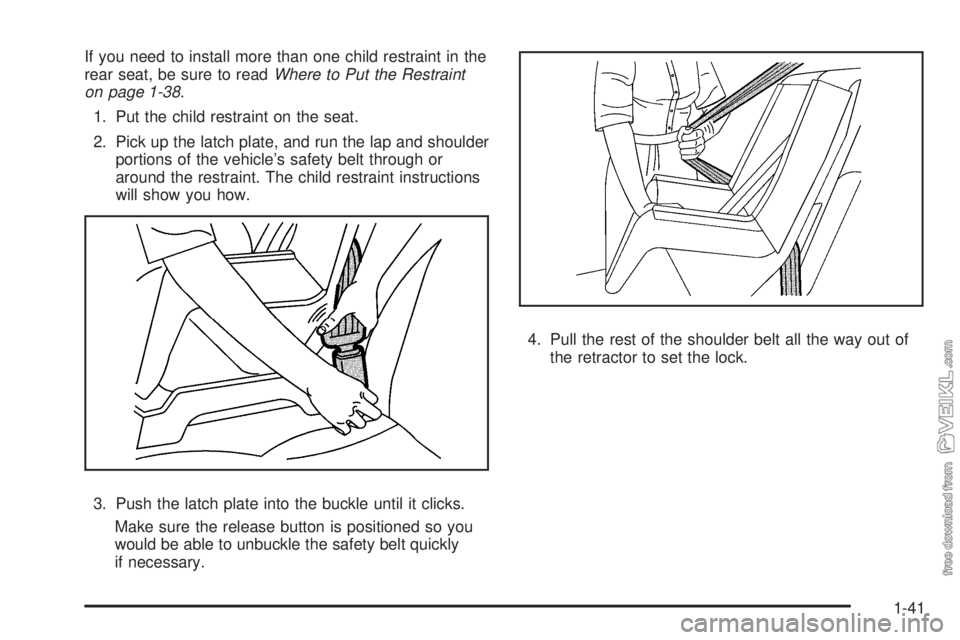
If you need to install more than one child restraint in the
rear seat, be sure to readWhere to Put the Restraint
on page 1-38.
1. Put the child restraint on the seat.
2. Pick up the latch plate, and run the lap and shoulder
portions of the vehicle’s safety belt through or
around the restraint. The child restraint instructions
will show you how.
3. Push the latch plate into the buckle until it clicks.
Make sure the release button is positioned so you
would be able to unbuckle the safety belt quickly
if necessary.4. Pull the rest of the shoulder belt all the way out of
the retractor to set the lock.
1-41
Page 46 of 384
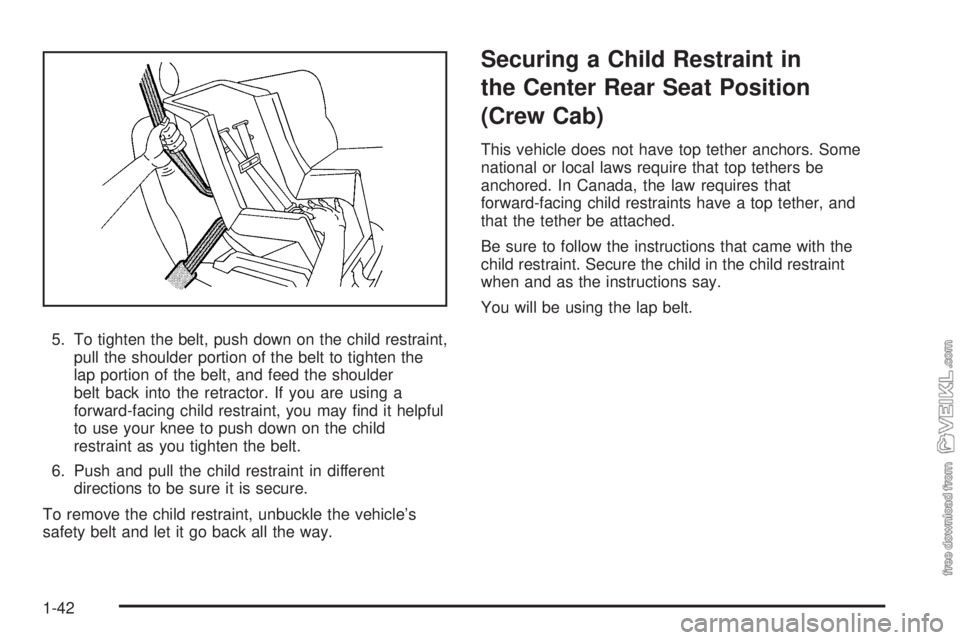
5. To tighten the belt, push down on the child restraint,
pull the shoulder portion of the belt to tighten the
lap portion of the belt, and feed the shoulder
belt back into the retractor. If you are using a
forward-facing child restraint, you may find it helpful
to use your knee to push down on the child
restraint as you tighten the belt.
6. Push and pull the child restraint in different
directions to be sure it is secure.
To remove the child restraint, unbuckle the vehicle’s
safety belt and let it go back all the way.
Securing a Child Restraint in
the Center Rear Seat Position
(Crew Cab)
This vehicle does not have top tether anchors. Some
national or local laws require that top tethers be
anchored. In Canada, the law requires that
forward-facing child restraints have a top tether, and
that the tether be attached.
Be sure to follow the instructions that came with the
child restraint. Secure the child in the child restraint
when and as the instructions say.
You will be using the lap belt.
1-42
Page 47 of 384
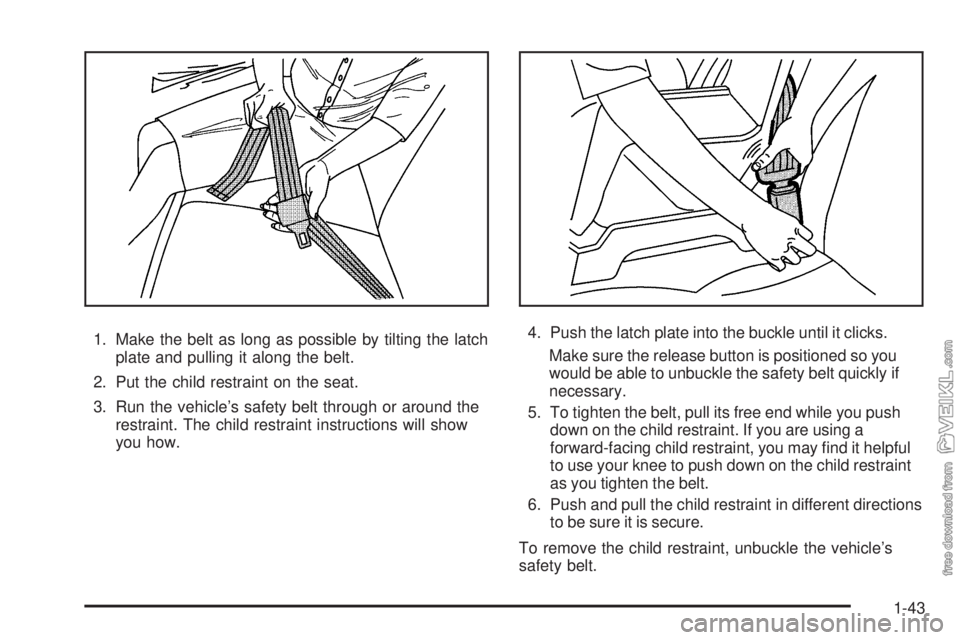
1. Make the belt as long as possible by tilting the latch
plate and pulling it along the belt.
2. Put the child restraint on the seat.
3. Run the vehicle’s safety belt through or around the
restraint. The child restraint instructions will show
you how.4. Push the latch plate into the buckle until it clicks.
Make sure the release button is positioned so you
would be able to unbuckle the safety belt quickly if
necessary.
5. To tighten the belt, pull its free end while you push
down on the child restraint. If you are using a
forward-facing child restraint, you may find it helpful
to use your knee to push down on the child restraint
as you tighten the belt.
6. Push and pull the child restraint in different directions
to be sure it is secure.
To remove the child restraint, unbuckle the vehicle’s
safety belt.
1-43
Page 48 of 384
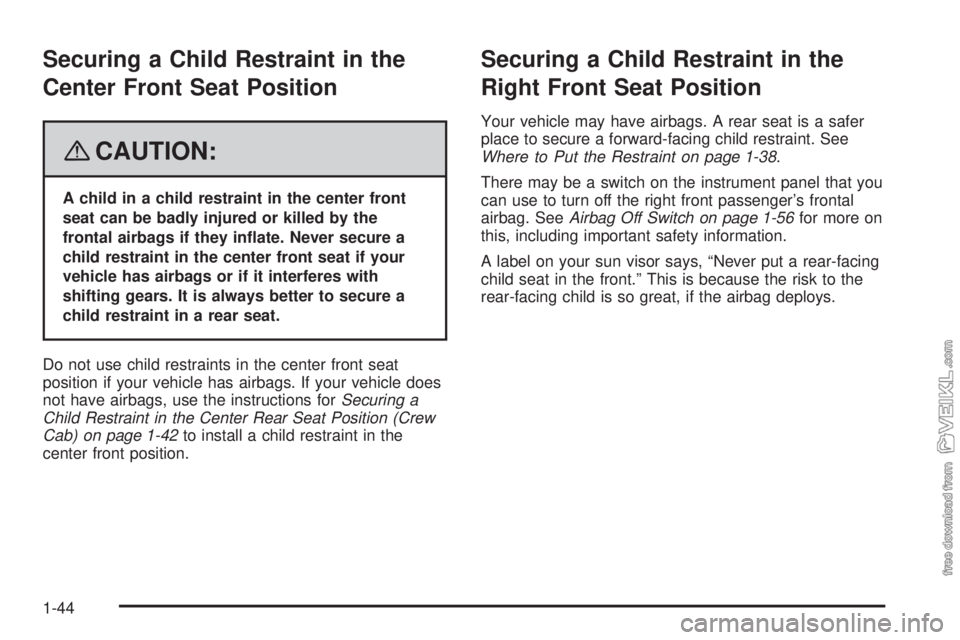
Securing a Child Restraint in the
Center Front Seat Position
{CAUTION:
A child in a child restraint in the center front
seat can be badly injured or killed by the
frontal airbags if they in�ate. Never secure a
child restraint in the center front seat if your
vehicle has airbags or if it interferes with
shifting gears. It is always better to secure a
child restraint in a rear seat.
Do not use child restraints in the center front seat
position if your vehicle has airbags. If your vehicle does
not have airbags, use the instructions forSecuring a
Child Restraint in the Center Rear Seat Position (Crew
Cab) on page 1-42to install a child restraint in the
center front position.
Securing a Child Restraint in the
Right Front Seat Position
Your vehicle may have airbags. A rear seat is a safer
place to secure a forward-facing child restraint. See
Where to Put the Restraint on page 1-38.
There may be a switch on the instrument panel that you
can use to turn off the right front passenger’s frontal
airbag. SeeAirbag Off Switch on page 1-56for more on
this, including important safety information.
A label on your sun visor says, “Never put a rear-facing
child seat in the front.” This is because the risk to the
rear-facing child is so great, if the airbag deploys.
1-44
Page 49 of 384
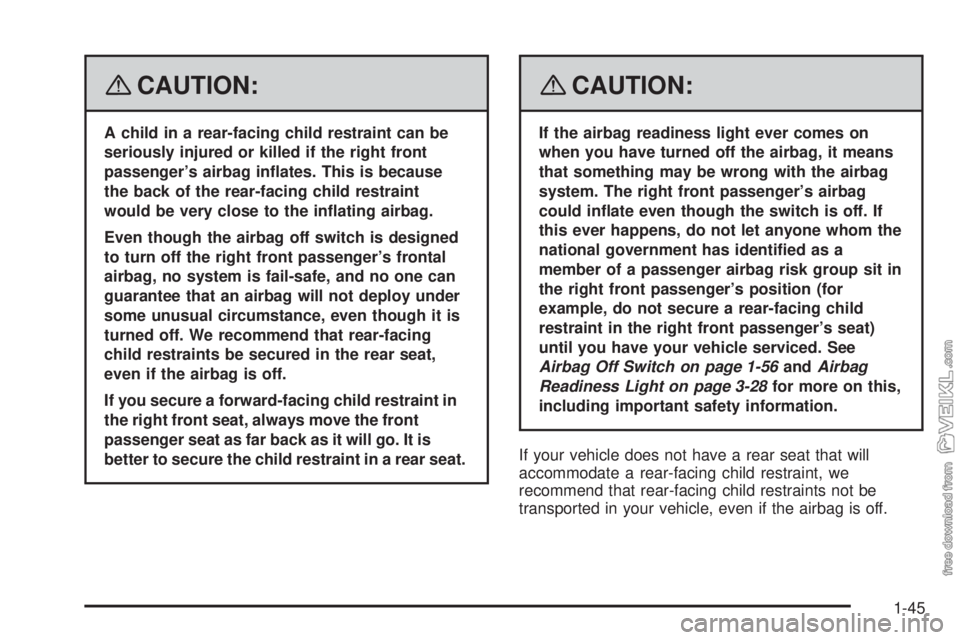
{CAUTION:
A child in a rear-facing child restraint can be
seriously injured or killed if the right front
passenger’s airbag in�ates. This is because
the back of the rear-facing child restraint
would be very close to the in�ating airbag.
Even though the airbag off switch is designed
to turn off the right front passenger’s frontal
airbag, no system is fail-safe, and no one can
guarantee that an airbag will not deploy under
some unusual circumstance, even though it is
turned off. We recommend that rear-facing
child restraints be secured in the rear seat,
even if the airbag is off.
If you secure a forward-facing child restraint in
the right front seat, always move the front
passenger seat as far back as it will go. It is
better to secure the child restraint in a rear seat.
{CAUTION:
If the airbag readiness light ever comes on
when you have turned off the airbag, it means
that something may be wrong with the airbag
system. The right front passenger’s airbag
could in�ate even though the switch is off. If
this ever happens, do not let anyone whom the
national government has identi�ed as a
member of a passenger airbag risk group sit in
the right front passenger’s position (for
example, do not secure a rear-facing child
restraint in the right front passenger’s seat)
until you have your vehicle serviced. See
Airbag Off Switch on page 1-56andAirbag
Readiness Light on page 3-28for more on this,
including important safety information.
If your vehicle does not have a rear seat that will
accommodate a rear-facing child restraint, we
recommend that rear-facing child restraints not be
transported in your vehicle, even if the airbag is off.
1-45
Page 50 of 384
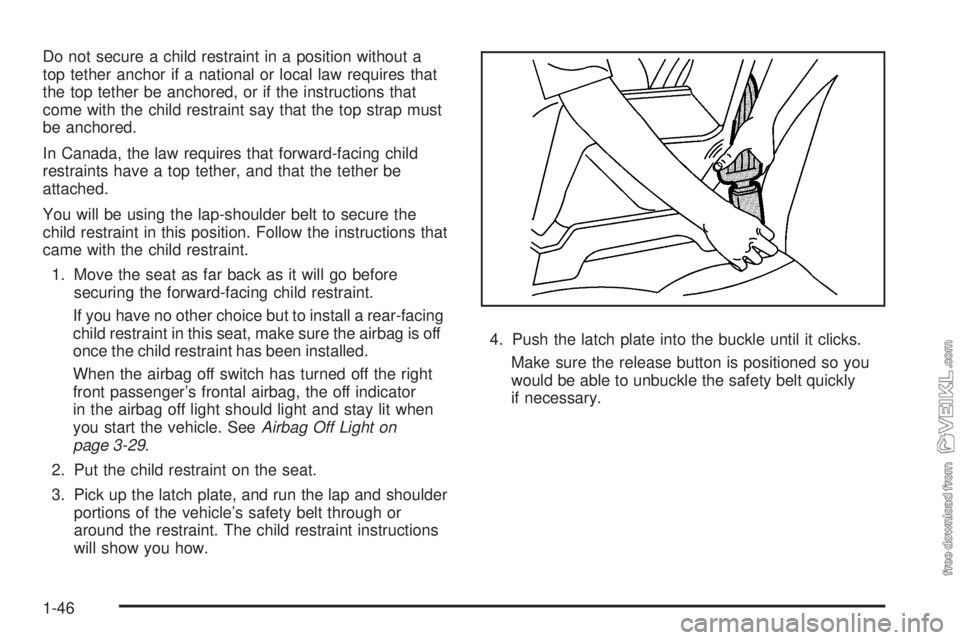
Do not secure a child restraint in a position without a
top tether anchor if a national or local law requires that
the top tether be anchored, or if the instructions that
come with the child restraint say that the top strap must
be anchored.
In Canada, the law requires that forward-facing child
restraints have a top tether, and that the tether be
attached.
You will be using the lap-shoulder belt to secure the
child restraint in this position. Follow the instructions that
came with the child restraint.
1. Move the seat as far back as it will go before
securing the forward-facing child restraint.
If you have no other choice but to install a rear-facing
child restraint in this seat, make sure the airbag is off
once the child restraint has been installed.
When the airbag off switch has turned off the right
front passenger’s frontal airbag, the off indicator
in the airbag off light should light and stay lit when
you start the vehicle. SeeAirbag Off Light on
page 3-29.
2. Put the child restraint on the seat.
3. Pick up the latch plate, and run the lap and shoulder
portions of the vehicle’s safety belt through or
around the restraint. The child restraint instructions
will show you how.4. Push the latch plate into the buckle until it clicks.
Make sure the release button is positioned so you
would be able to unbuckle the safety belt quickly
if necessary.
1-46